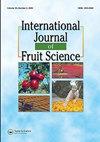Comparison of Wood Mulch Particle Sizes for Wild Blueberry Management in a Changing Climate
IF 2.4
3区 农林科学
Q2 HORTICULTURE
引用次数: 5
Abstract
ABSTRACT Climate change in Maine is characterized by increasing rates of warming temperatures and more intense rain events, which lead to altered growing seasons, earlier emergence of pests, increased seasonal drought and large crop losses. These changes have significant impacts on wild blueberry systems and make it more difficult for growers to manage this crop under increasingly unpredictable weather patterns. Mulching is a tool growers use to combat some of these challenges, but the comparative effects of wood mulch particle size in wild blueberry systems has not been studied. The purpose of this study was to determine the effect of wood mulch particle size on wild blueberry soil, plant development, pest pressure, and yield. This study was carried out over a 2-year period (one production cycle) in an organic wild blueberry field in Stockton Springs, ME. There was no mulch particle size treatment used in this study that demonstrated significantly greater overall mean soil moisture compared to the control at the 1.27 cm application thickness. All mulch treatments significantly reduced disease pressure, primarily Sphaerulina leaf spot caused by Sphaerulina vaccinii, compared to the control in year 1. The two finest particle size treatments, sawdust and shavings, resulted in significantly greater yields than the control, and were the least expensive materials. This suggests that growers should consider using finer particle size mulches rather than the current practice, wood chips, but may need to reapply more frequently. From this study, application of softwood mulch of any particle size is better than no application.气候变化下野生蓝莓木覆盖物粒径的比较研究
缅因州气候变化的特点是气温上升速度加快,降雨事件增多,导致生长季节改变,害虫提前出现,季节性干旱增加,作物损失大。这些变化对野生蓝莓系统产生了重大影响,并使种植者在日益不可预测的天气模式下更难管理这种作物。覆盖是种植者用来应对这些挑战的一种工具,但木材覆盖颗粒大小在野生蓝莓系统中的比较效果尚未研究。本研究的目的是确定木膜粒径对野生蓝莓土壤、植株发育、害虫压力和产量的影响。本研究在缅因州斯托克顿斯普林斯的一个有机野生蓝莓田进行了为期2年(一个生产周期)的研究。在本研究中,没有使用覆盖粒径处理,与1.27 cm施用厚度的对照相比,显示出明显更高的总体平均土壤湿度。在第1年,与对照相比,所有覆盖处理都显著降低了病压,主要是由牛痘球藻引起的球藻叶斑病。两种最细粒度的处理,木屑和刨花,产量显著高于对照,是最便宜的材料。这表明种植者应该考虑使用更细粒度的覆盖物,而不是目前的做法,木屑,但可能需要更频繁地重新施用。从本研究来看,施用任何粒径的软木地膜都比不施用好。
本文章由计算机程序翻译,如有差异,请以英文原文为准。
求助全文
约1分钟内获得全文
求助全文
来源期刊

International Journal of Fruit Science
Agricultural and Biological Sciences-Agronomy and Crop Science
CiteScore
6.40
自引率
0.00%
发文量
64
审稿时长
10 weeks
期刊介绍:
The International Journal of Fruit Science disseminates results of current research that are immediately applicable to the grower, extension agent, and educator in a useful, legitimate, and scientific format. The focus of the journal is on new technologies and innovative approaches to the management and marketing of all types of fruits. It provides practical and fundamental information necessary for the superior growth and quality of fruit crops.
This journal examines fruit growing from a wide range of aspects, including:
-genetics and breeding
-pruning and training
-entomology, plant pathology, and weed science
-physiology and cultural practices
-marketing and economics
-fruit production, harvesting, and postharvest
 求助内容:
求助内容: 应助结果提醒方式:
应助结果提醒方式:


